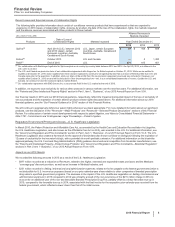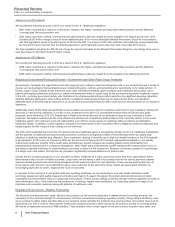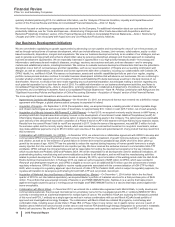Pfizer 2015 Annual Report Download - page 16
Download and view the complete annual report
Please find page 16 of the 2015 Pfizer annual report below. You can navigate through the pages in the report by either clicking on the pages listed below, or by using the keyword search tool below to find specific information within the annual report.
Financial Review
Pfizer Inc. and Subsidiary Companies
2015 Financial Report
15
The accounting for benefit plans is highly dependent on actuarial estimates, assumptions and calculations, which can result from a complex
series of judgments about future events and uncertainties. The assumptions and actuarial estimates required to estimate the employee benefit
obligations for the defined benefit and postretirement plans include the discount rate; expected salary increases; certain employee-related
factors, such as turnover, retirement age and mortality (life expectancy); expected return on assets; and healthcare cost trend rates.
In the fourth quarter of 2014, we approved a change, effective January 1, 2016, to the U.S. postretirement medical plan to transfer certain plan
participants to a retiree drug coverage program eligible for a Medicare Part D plan subsidy (Employer Group Waiver Plan). This change
resulted in a decrease to the postretirement benefit obligation of approximately $600 million as of December 31, 2014.
As of December 31, 2015, the noncurrent portion of our pension benefit obligations, net, and our postretirement benefit obligations, net
decreased, in the aggregate, by approximately $2.1 billion compared to December 31, 2014. The decrease reflects, among other things, an
increase in our discount rate assumptions used in the measurement of the plan obligations, a $1 billion voluntary contribution made in
January, 2015, a plan amendment approved in June 2015 that introduced a cap on costs for certain groups within the U.S. postretirement
medical plan, and a rise in the comparative strength of the U.S. dollar, as compared to other currencies.
Our assumptions reflect our historical experiences and our judgment regarding future expectations that have been deemed reasonable by
management. The judgments made in determining the costs of our benefit plans can materially impact our results of operations.
The following table provides (i) at the end of each year, the expected annual rate of return on plan assets for the following year, (ii) the actual
annual rate of return on plan assets achieved in each year, and (iii) the weighted-average discount rate used to measure the benefit
obligations at the end of each year for our U.S. qualified pension plans and our international pension plans(a):
2015 2014 2013
U.S. Qualified Pension Plans
Expected annual rate of return on plan assets 8.0% 8.3% 8.5%
Actual annual rate of return on plan assets (0.8)6.8 11.3
Discount rate used to measure the plan obligations 4.5 4.2 5.2
International Pension Plans
Expected annual rate of return on plan assets 5.2 5.5 5.8
Actual annual rate of return on plan assets 3.6 13.2 13.1
Discount rate used to measure the plan obligations 3.1 3.0 3.9
(a) For detailed assumptions associated with our benefit plans, see Notes to Consolidated Financial Statements—Note 11B. Pension and Postretirement Benefit
Plans and Defined Contribution Plans: Actuarial Assumptions.
Expected Annual Rate of Return on Plan Assets
The assumptions for the expected annual rate of return on all of our plan assets reflect our actual historical return experience and our long-
term assessment of forward-looking return expectations by asset classes, which is used to develop a weighted-average expected return based
on the implementation of our targeted asset allocation in our respective plans.
The expected annual rate of return on plan assets for our U.S. plans and the majority of our international plans is applied to the fair value of
plan assets at each year-end and the resulting amount is reflected in our net periodic benefit costs in the following year. In January 2016,
Pfizer made a voluntary contribution of $1.0 billion to plan assets. In 2016, this contribution will be included in the plan asset balance for
purposes of determining the expected return on plan assets.
The following table illustrates the sensitivity of net periodic benefit costs to a 50 basis point decline in our assumption for the expected annual
rate of return on plan assets, holding all other assumptions constant (in millions, pre-tax):
Change
Increase in 2016 Net
Periodic Benefit Costs
Assumption
Expected annual rate of return on plan assets 50 basis point decline $98
The actual return on plan assets resulted in a net gain on our plan assets of approximately $163 million during 2015.
Discount Rate Used to Measure Plan Obligations
The weighted-average discount rate used to measure the plan obligations for our U.S. defined benefit plans is determined at least annually
and evaluated and modified, as required, to reflect the prevailing market rate of a portfolio of high-quality fixed income investments, rated AA/
Aa or better, that reflect the rates at which the pension benefits could be effectively settled. The discount rate used to measure the plan
obligations for our international plans is determined at least annually by reference to investment grade corporate bonds, rated AA/Aa or better,
including, when there are sufficient data, a yield-curve approach. These discount rate determinations are made in consideration of local
requirements.
The measurement of the plan obligations at the end of the year will affect the amount of service cost, interest cost and amortization expense
reflected in our net periodic benefit costs in the following year.
























